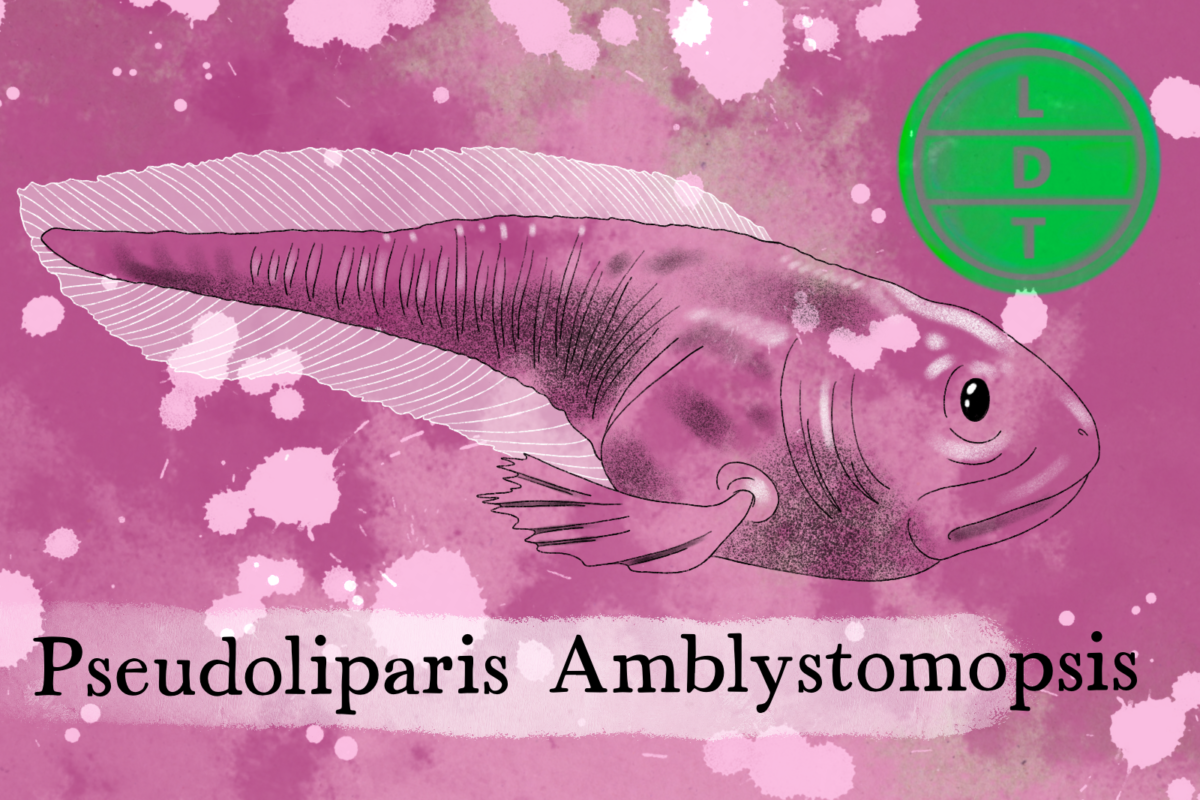“…and today we’re talking about the cousin of an alumni. But more on that later.”
Deep in the water where no fish hang out lives a glum, gloomy swimmer with some ever-present clout. The hadal snailfish lives where pretty much nothing else can live – the hadal zone. The pressure and temperature of the water alone make it almost impossible for anything with DNA to survive, and that includes just about every living thing – plant or animal. But with some zest adaptations and prepper’s supply of extra genes, it’s all good in the neighborhood here in Life, Death, and Taxonomy..
Description of the Hadal Fish
- Sightings are rare, since they live so far down, but there have been sightings and photographs.
- The hadal snailfish looks a lot like the Mariana snailfish.
- Its body is generally tadpole shaped, with large broad pectoral fins on their sides.
- Snailfish in the family liparidae have different looks and features depending on the oceanic trench they come from. They may be whitish pink, tan, orange, or brown.
- The Hadal and Mariana snailfish seem to be one uniform color, but some snailfish are spotted, mottled, or stripped.
Measure Up
List these in order from most to least populous in the United States?
- Black bears 2
- Deer 1
- Wolves 4
- Bison 3
Length
- 8.9–28.8 cm
- How many hadal snailfish go into the length of the General Sherman sequoia?
- Hint: General Sherman is a sequoia in Sequoia National Park in California. Along with humans and a few birds, sequoias are among the rare species that enjoy fire. Fire is an important feature in the lifecycle of the tree, clearing away leaf litter to make way for new saplings. In fact, sequoia pine cones are designed to open in intense heat.
- 288 snailfish. The tree is 275 feet (83 m).
Weight
- 7 to 160 g (4.6 ounces)
- If we average the weight of a black bear to 265 pounds, how many hadal snailfish go into the total weight of all the black bears in the United States?
- Hint: There are more American Black Bears in the U.S. than there are grizzlies in the world. One reason black bears do well while grizzlies suffer is that they are more adaptable to human presence. Grizzlies kill twice as many humans than black bears. Black beers can also live on a wider variety of food, like a raccoon. In Yosemite, black bears are mostly vegetarian, eating grass in the spring, berries in the summer, and acorns in the fall.
- 276,521,739 hadal snailfish. There are 300,000 black bears in the U.S.
Fast Facts about the Hadal Fish
The hadal snailfish is named after the hadal zone of the ocean, where it lives. The Hadal zone refers to the deepest parts of the ocean in oceanic trenches.
Different species of snailfish are local to different trenches. The hadal snailfish is native to trenches near Japan.
The hadal snailfish is apparently first described by soviet ichthyologist Anatoly Petrovich Andriyashev in 1955, which is surprising considering how many deep sea creatures have been discovered more recently.
In October 2008, British and Japanese researchers found the Hadal snailfish and extreme depths in a Pacific trench in Japan. For a while, it was considered to be the deepest living fish, until it was surpassed by the Mariana Snailfish. However, there is yet an undescribed species called the ethereal snailfish that is said to be deeper.
Major Fact: 20,000 leagues under the sea (or just 1.4 leagues)
- I actually thought that the book took place at a depth of 20,000 leagues, which would be 68,000 miles or 359 million feet.
- The hadal snailfish recently made news as one of the fish with the deepest living depth.
- Reports are saying that other snailfish have been discovered deeper, but they haven’t been named or described yet so we’re not even sure if they’re different species.
- The hadal zone is the deepest layer of the ocean starting at around 20,000 ft below sea level
- The hadal snailfish species can live up to over 26,000 ft
- This amounts to 812 atm of pressure or 12,000 lb per square inch
- The pressure at this depth is enough to break down your DNA, so almost no living thing can survive
- But the snailfish has a few adaptations that allow it to not turn into protein goop
- First, it has extra genes to replace the ones being damaged by the pressure, so it can easily repair itself.
- Second, it has five copies of a gene that takes an enzyme produced by gut fauna and turns it into a compound called trimethylamine, which stabilizes the DNA proteins under extreme hydrostatic pressure.
- This comes at a cost though, and the snailfish lacks the genes for vision, smell, and taste, which aren’t all that relevant when you’re a fish at the bottom of the bottom of a trench at the bottom of the ocean.
- Kinda like a sci-fi spaceship that has to route power from the shields to enhance the engines or torpedoes or whatever, even though that’s not really how electricity works.
- Of course, a lot of this still needs research. But as we mentioned in the blobfish episode, studying deep-sea fish pretty much has to be done down in their neighborhood, otherwise they’ll explode, which tends to hamper scientific efforts.
Ending: So stock up on some of Uncle John’s Old Fashioned trimethylamine, route all genetic power to the repair bay, and go further than any fish has gone before like the hadal snailfish here in LDT.

